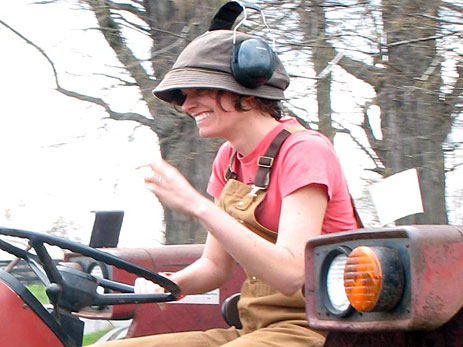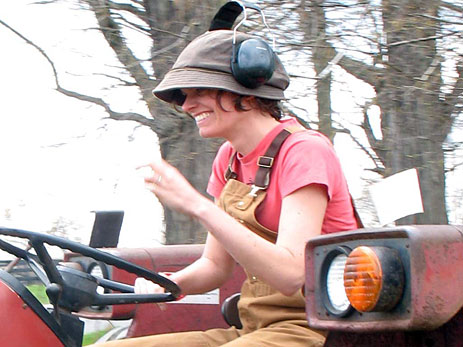
The author on her tractor: Lindsey and her husband run Pistil Farm and Hearty Roots Community Farm in Tivoli, N.Y.
More and more Millennials are rejecting Cubicleville and instead opting for hands-on professions, including farming — and not a minute too soon.
Over the last hundred years, the number of young people in agriculture has steadily declined, from 1.8 million principal farm operators in 1910 to just 118,000 today, according to the USDA’s Agricultural Census. As of 2007, for each farmer under 35, there were six over sixty-five. Since 2002 there’s been a slight uptick in the number of farmers (not just the principals) between the ages of 25 and 34, but the overall number of farmers under 35 increased by only 2,000.
Unless an agricultural revival and major policy change begins now, the numbers of farmers will certainly shrink: the Wisconsin Department of Agriculture estimates that 500,000 farmers will retire in the next 20 years.
And that’s why U.S. Secretary of Agriculture Tom Vilsack recently called for 100,000 new farmers, and some of the few uncontroversial elements of the last Farm Bill were the handful of programs and provisions for new and beginning farmers. The government offers Beginning Farmer and Rancher Development Program grants (which provide funds for universities and nonprofits to train farmers) as well as direct loans to farmers to operate their farms or buy land.
The problem is, many young farmers say that they don’t know about these programs, are disqualified because of existing rules, or receive misinformation at the local level that prevents them from participating.
At the recent Young Farmers Conference at the Stone Barns Center for Food and Agriculture in New York, the speakers at a special policy workshop organized by the National Young Farmers’ Coalition, which I lead, shared their experiences with Farm Bill programs and ideas for change.
Loanerous terms
Cara Fraver of Quincy Farm was disappointed that she and her partner, Luke Deikis, were turned down for a Farm Service Agency (FSA) loan when they were looking to purchase land to start an organic CSA farm this year. The FSA makes low-interest loans to beginning farmers to operate, buy, or make a down payment on farm land, but the pair was disqualified because they lacked three years’ of experience operating a farm business. Instead, Cara and Luke had spent their last three farm seasons working at other CSA farms, saving money, and developing a business plan.
The USDA requires that loan recipients participate in the business operations of a farm for three years before applying for a loan to ensure a “reasonable prospect of success” for a farm. Applicants must prove that they were “more than a laborer” at the farms they’ve worked at by showing checks that they signed for the farm, bills addressed to them, or a written statements from the principal farmer describing their role on the farm.
Even with the right level of experience, the FSA loan approval process is proving too slow for farmers looking to buy land in competitive real-estate markets. Benjamin Shute, of Hearty Roots Farm in the Hudson Valley, considered applying for a loan to purchase land in his town, but needed to put in an offer on a farm before FSA could respond to his application. FSA doesn’t offer pre-approval, meaning that farmers can’t quickly bid on a property. Without pre-approval, loans are only useful in slower markets or in a situation where an existing farm owner can afford to be patient with a potential buyer.
Deer prudence
Another way the Farm Bill seeks to help beginning farmers is by reserving program funding for beginning farmers. One such program is the Environmental Quality Incentives Program (EQIP) that pays up to 90 percent of the cost of conservation structures and the implementation of good management practices. Five percent of EQIP funds are reserved for new and beginning farmers.
Recalling the experience building a deer fence with EQIP funds on her farm in Connecticut, Dina Brewster of The Hickories sees room for improvement. Dina needed three-quarters of a mile of fence to keep her fields of organic vegetables and fruit safe from local deer. After fronting $50,000 to build the fence, she became snared between competing USDA rules — those that made her farm certified organic and another set that suggested she maintain her fence with Round-up, a broad spectrum herbicide that is not on the organic list.
The conflict put the 90 percent reimbursement that she was promised — a business-breaking $45,000 — in jeopardy. Only after weeks of calls and letters to the agency did she get final approval and a check in the mail. Dina was thankful for the fence, but exhausted by the experience.
Are you listening, Mr. Vilsack?
The National Young Farmers’ Coalition hopes that USDA staff brought back these farmers’ stories to the Secretary of Agriculture. If he wants to see 100,000 new American farmers in the next few years, improving existing programs for young and beginning farmers can’t be overlooked.
Get off your ass alert: Interested in farming? Try volunteering on an organic farm first through WWOOF.




